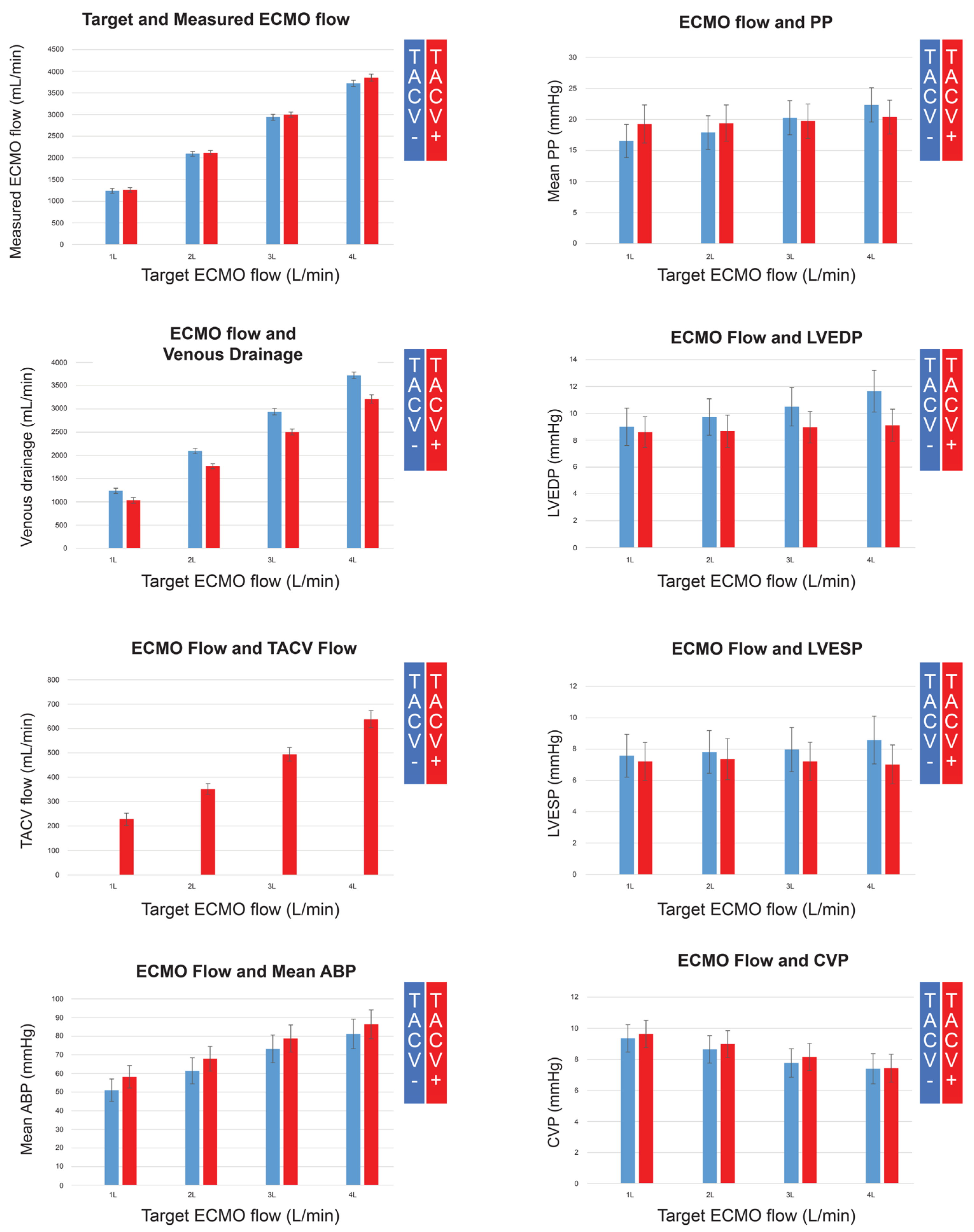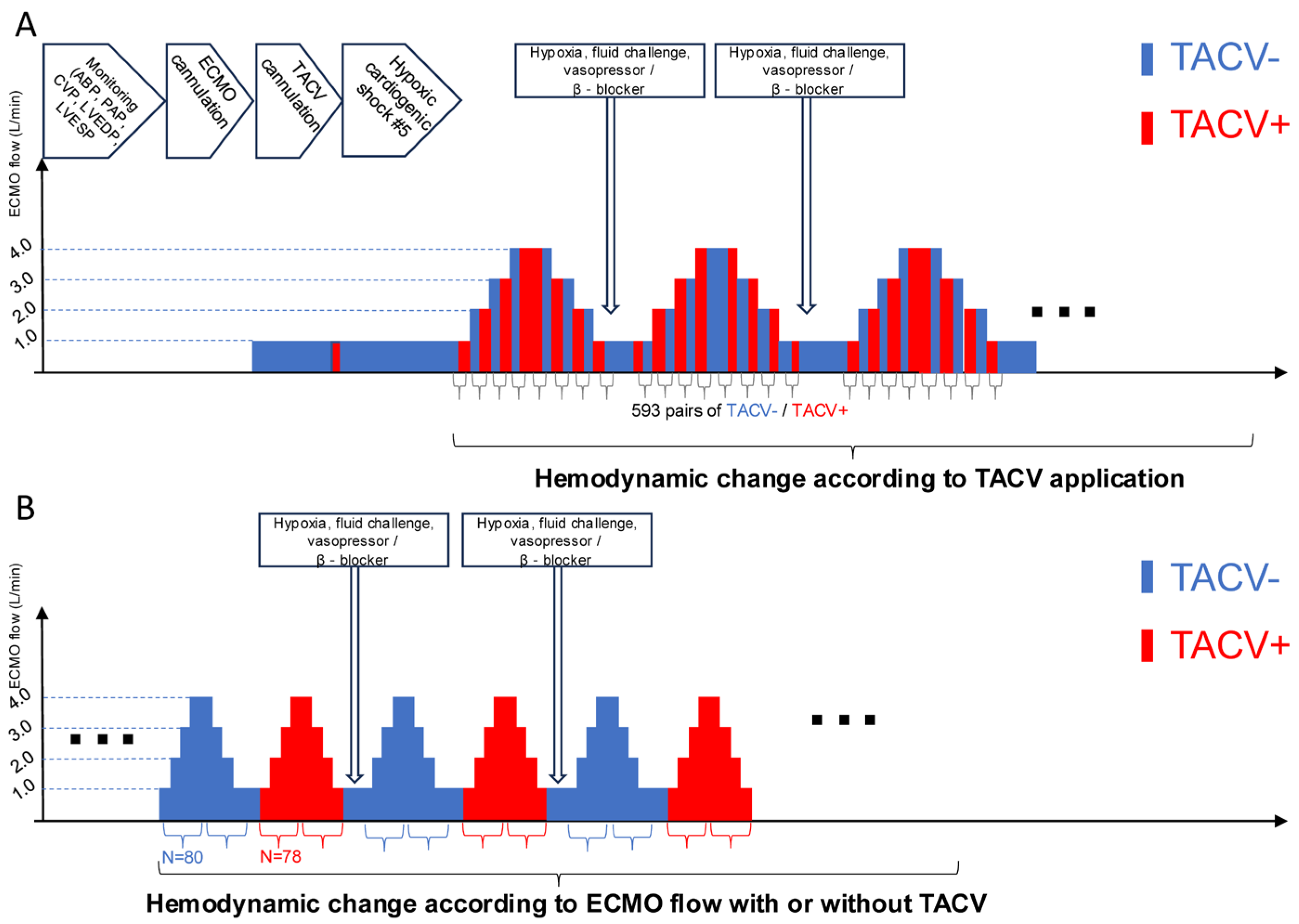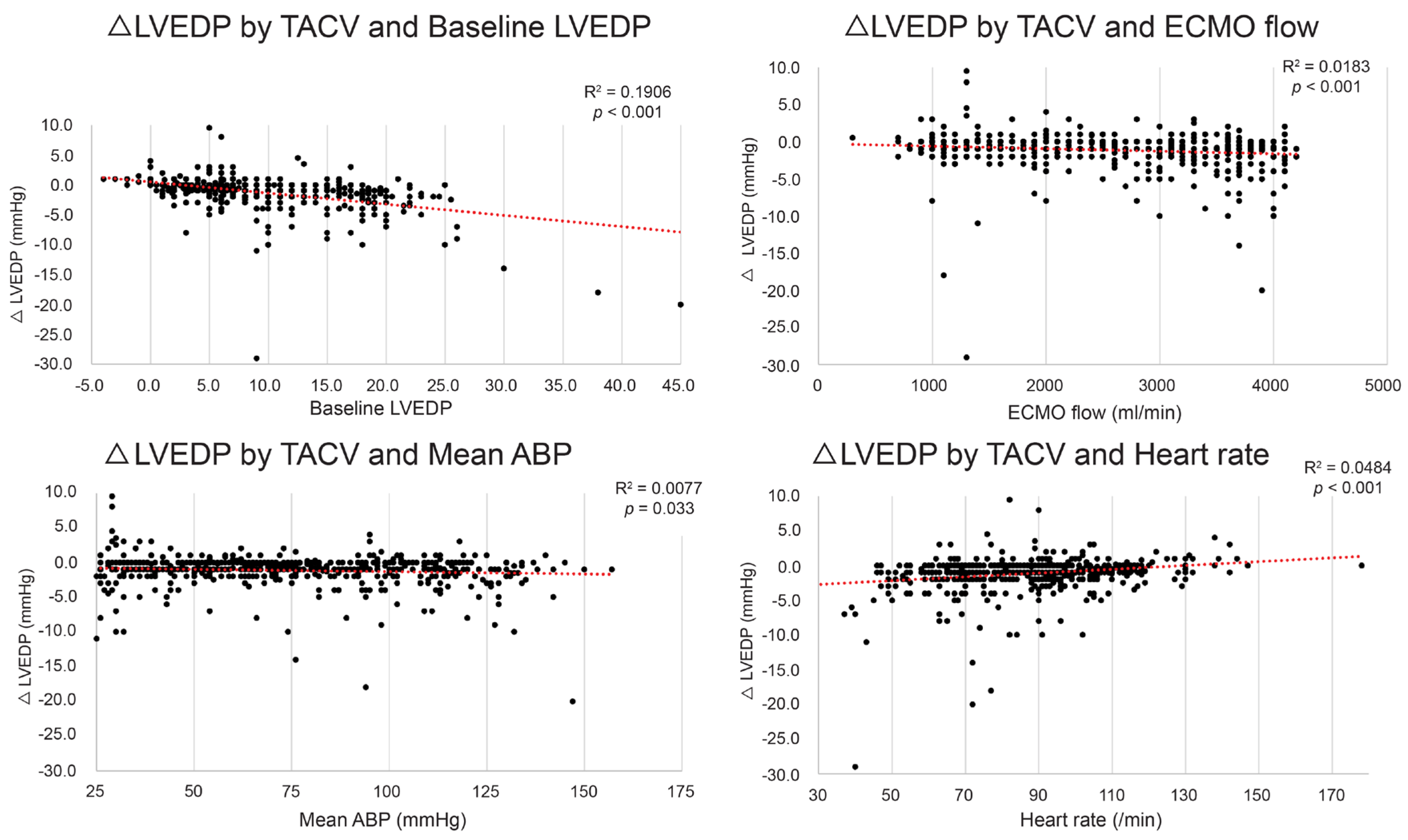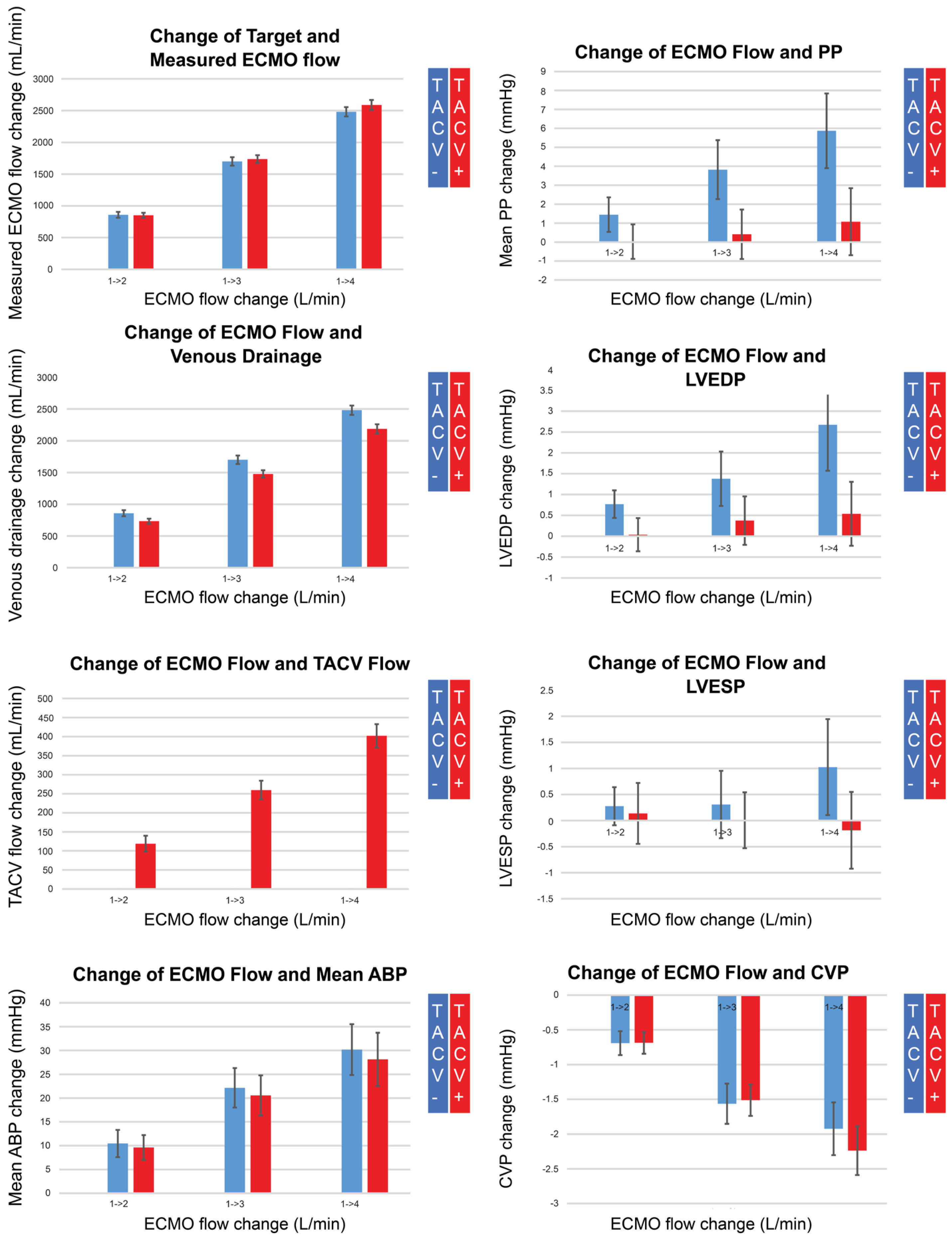Transaortic Catheter Venting for Left Ventricular Unloading in Veno-Arterial Extracorporeal Life Support: A Porcine Cardiogenic Shock Model
Abstract
:1. Introduction
2. Materials and Methods
2.1. Study Design and Subjects
2.2. Procedures and Protocols
2.3. Statistical Analysis
3. Results
3.1. Hemodynamic Change According to TACV Application
3.2. Hemodynamic Change According to ECMO Flow with or Without TACV
4. Discussion
5. Conclusions
Supplementary Materials
Author Contributions
Funding
Institutional Review Board Statement
Informed Consent Statement
Data Availability Statement
Acknowledgments
Conflicts of Interest
Appendix A
| Characteristics | Median (Interquartile Range) |
|---|---|
| Body weight (kg) | 55 (51–65) |
| Initial systolic ABP (mmHg) | 109 (96–117) |
| Initial diastolic ABP (mmHg) | 74 (61–77) |
| Initial mean ABP (mmHg) | 87 (74–91) |
| Initial systolic PAP (mmHg) | 24 (21–29) |
| Initial diastolic PAP (mmHg) | 17 (9–19) |
| Initial mean PAP (mmHg) | 22 (17–23) |
| Initial CVP (mmHg) | 7 (5–9) |
| Initial LVEDP (mmHg) | 10 (6–10) |
| Initial LVESP (mmHg) | 2 (0–6) |
| Initial HR (/min) | 89 (85–93) |
| Initial cardiac output (L/min) | 4.6 (3.7–5.1) |
| Body temperature (°C) | 36.2 (36.0–36.8) |
| Initial pH | 7.5 (7.5–7.6) |
| Initial pCO2 (mmHg) | 32.6 (24.9–37) |
| Initial O2 (mmHg) | 325.4 (275–348.5) |
| Initial Hematocrit (%) | 30 (29–34) |
| Initial Lactate (mmol/L) | 1.6 (1.2–2.2) |
| Initial Glucose (mg/dL) | 101 (64–123) |
| Initial Na+ (mmol/L) | 138.2 (137.3–138.4) |
| Initial K+ (mmol/L) | 3.8 (3.4–4.1) |
| Initial iCa2+(mmol/L) | 1.2 (1.1–1.4) |
| Time until ECMO run (min) | 75.3 (68.7–79.9) |
| Time until TACV (min) | 114.9 (77.9–148.1) |
| Experiment time (min) | 392.5 (314.1–457.1) |
| Observed events | 150 (95–222) |


References
- Kowalewski, M.; Malvindi, P.G.; Zielinski, K.; Martucci, G.; Slomka, A.; Suwalski, P.; Lorusso, R.; Meani, P.; Arcadipane, A.; Pilato, M.; et al. Left Ventricle Unloading with Veno-Arterial Extracorporeal Membrane Oxygenation for Cardiogenic Shock. Systematic Review and Meta-Analysis. J. Clin. Med. 2020, 9, 1039. [Google Scholar] [CrossRef] [PubMed]
- Rao, P.; Khalpey, Z.; Smith, R.; Burkhoff, D.; Kociol, R.D. Venoarterial Extracorporeal Membrane Oxygenation for Cardiogenic Shock and Cardiac Arrest. Circ. Heart Fail. 2018, 11, e004905. [Google Scholar] [CrossRef] [PubMed]
- Squiers, J.J.; Lima, B.; DiMaio, J.M. Contemporary extracorporeal membrane oxygenation therapy in adults: Fundamental principles and systematic review of the evidence. J. Thorac. Cardiovasc. Surg. 2016, 152, 20–32. [Google Scholar] [CrossRef]
- Cevasco, M.; Takayama, H.; Ando, M.; Garan, A.R.; Naka, Y.; Takeda, K. Left ventricular distension and venting strategies for patients on venoarterial extracorporeal membrane oxygenation. J. Thorac. Dis. 2019, 11, 1676–1683. [Google Scholar] [CrossRef]
- Ostadal, P.; Rokyta, R.; Karasek, J.; Kruger, A.; Vondrakova, D.; Janotka, M.; Naar, J.; Smalcova, J.; Hubatova, M.; Hromadka, M.; et al. Extracorporeal Membrane Oxygenation in the Therapy of Cardiogenic Shock: Results of the ECMO-CS Randomized Clinical Trial. Circulation 2023, 147, 454–464. [Google Scholar] [CrossRef]
- Lim, Y.; Kim, M.C.; Jeong, I.S. Left ventricle unloading during veno-arterial extracorporeal membrane oxygenation: Review with updated evidence. Acute Crit. Care 2024, 39, 473–487. [Google Scholar] [CrossRef]
- Desai, S.R.; Hwang, N.C. Strategies for Left Ventricular Decompression During Venoarterial Extracorporeal Membrane Oxygenation—A Narrative Review. J. Cardiothorac. Vasc. Anesth. 2020, 34, 208–218. [Google Scholar] [CrossRef]
- Soleimani, B.; Pae, W.E. Management of left ventricular distension during peripheral extracorporeal membrane oxygenation for cardiogenic shock. Perfusion 2012, 27, 326–331. [Google Scholar] [CrossRef]
- Meani, P.; Gelsomino, S.; Natour, E.; Johnson, D.M.; Rocca, H.B.; Pappalardo, F.; Bidar, E.; Makhoul, M.; Raffa, G.; Heuts, S.; et al. Modalities and Effects of Left Ventricle Unloading on Extracorporeal Life support: A Review of the Current Literature. Eur. J. Heart Fail. 2017, 19 (Suppl. S2), 84–91. [Google Scholar] [CrossRef] [PubMed]
- Meani, P.; Lorusso, R.; Pappalardo, F. ECPella: Concept, Physiology and Clinical Applications. J. Cardiothorac. Vasc. Anesth. 2022, 36, 557–566. [Google Scholar] [CrossRef]
- Feng, S.N.; Liu, W.L.; Kang, J.K.; Kalra, A.; Kim, J.; Zaqooq, A.; Vogelsong, M.A.; Kim, B.S.; Brodie, D.; Brown, P.; et al. Impact of Left Ventricular Venting on Acute Brain Injury in Patients with Cardiogenic Shock: An Extracorporeal Life Support Organization Registry Analysis. medRxiv 2024. [Google Scholar] [CrossRef]
- Saito, S.; Okubo, S.; Matsuoka, T.; Hirota, S.; Yokoyama, S.; Kanazawa, Y.; Takei, Y.; Tezuka, M.; Tsuchiya, G.; Konishi, T.; et al. Impella—Current issues and future expectations for the percutaneous, microaxial flow left ventricular assist device. J. Cardiol. 2024, 83, 228–235. [Google Scholar] [CrossRef]
- Zhang, H.; Wang, T.; Wang, J.; Liu, G.; Yan, S.; Teng, Y.; Wang, J.; Ji, B. Different strategies in left ventricle unloading during venoarterial extracorporeal membrane oxygenation: A network meta-analysis. Int. J. Cardiol. Heart Vasc. 2024, 54, 101506. [Google Scholar] [CrossRef]
- Hong, T.H.; Byun, J.H.; Lee, H.M.; Kim, Y.H.; Kang, G.H.; Oh, J.H.; Hwang, S.W.; Kim, H.Y.; Park, J.H.; Jung, J.J. Initial Experience of Transaortic Catheter Venting in Patients with Venoarterial Extracorporeal Membrane Oxygenation for Cardiogenic Shock. ASAIO J. 2016, 62, 117–122. [Google Scholar] [CrossRef]
- Jung, J.J.; Kang, D.H.; Moon, S.H.; Yang, J.H.; Kim, S.H.; Kim, J.W.; Byun, J.H. Left Ventricular Decompression by Transaortic Catheter Venting in Extracorporeal Membrane Oxygenation. ASAIO J. 2021, 67, 752–756. [Google Scholar] [CrossRef]
- Kitamura, M.; Hanzawa, K.; Takekubo, M.; Aoki, K.; Hayashi, J. Preclinical assessment of a transaortic venting catheter for percutaneous cardiopulmonary support. Artif. Organs 2004, 28, 298–302. [Google Scholar] [CrossRef]
- Lusebrink, E.; Binzenhofer, L.; Kellnar, A.; Muller, C.; Scherer, C.; Schrage, B.; Joskowiak, D.; Petzold, T.; Braun, D.; Brunner, S.; et al. Venting during venoarterial extracorporeal membrane oxygenation. Clin. Res. Cardiol. 2023, 112, 464–505. [Google Scholar] [CrossRef]
- Meani, P.; Mlcek, M.; Kowalewski, M.; Raffa, G.M.; Popkova, M.; Pilato, M.; Arcadipane, A.; Belohlavek, J.; Lorusso, R. Transaortic or Pulmonary Artery Drainage for Left Ventricular Unloading in Venoarterial Extracorporeal Life Support: A Porcine Cardiogenic Shock Model. Semin. Thorac. Cardiovasc. Surg. 2021, 33, 724–732. [Google Scholar] [CrossRef]
- Leistner, D.M.; Dietrich, S.; Erbay, A.; Steiner, J.; Abdelwahed, Y.; Siegrist, P.T.; Schindler, M.; Skurk, C.; Haghikia, A.; Sinning, D.; et al. Association of left ventricular end-diastolic pressure with mortality in patients undergoing percutaneous coronary intervention for acute coronary syndromes. Catheter. Cardiovasc. Interv. 2020, 96, E439–E446. [Google Scholar] [CrossRef]
- Na, S.J.; Yang, J.H.; Yang, J.H.; Sung, K.; Choi, J.O.; Hahn, J.Y.; Jeon, E.S.; Cho, Y.H. Left heart decompression at venoarterial extracorporeal membrane oxygenation initiation in cardiogenic shock: Prophylactic versus therapeutic strategy. J. Thorac. Dis. 2019, 11, 3746–3756. [Google Scholar] [CrossRef]
- Schrage, B.; Becher, P.M.; Bernhardt, A.; Bezerra, H.; Blankenberg, S.; Brunner, S.; Colson, P.; Cudemus Deseda, G.; Dabboura, S.; Eckner, D.; et al. Left Ventricular Unloading Is Associated with Lower Mortality in Patients with Cardiogenic Shock Treated with Venoarterial Extracorporeal Membrane Oxygenation: Results From an International, Multicenter Cohort Study. Circulation 2020, 142, 2095–2106. [Google Scholar] [CrossRef]
- Solholm, A.; Salminen, P.R.; Stangeland, L.; Dahle, G.O.; Mongstad, A.; Svenheim, B.; Zhang, L.; Haaverstad, R.; Grong, K. Left ventricular venting during extracorporeal membrane oxygenation; the effects on cardiac performance in a porcine model of critical post-cardiotomy failure. Perfusion 2023, 38, 1399–1408. [Google Scholar] [CrossRef]
- Hala, P.; Mlcek, M.; Ostadal, P.; Popkova, M.; Janak, D.; Boucek, T. Increasing venoarterial extracorporeal membrane oxy-genation flow puts higher demands on left ventricular work in a porcine model of chronic heart failure. J. Transl. Med. 2020, 18, 75. [Google Scholar] [CrossRef]
- Alhussein, M.; Moayedi, Y.; Posada, J.D.; Ross, H.; Hickey, E.; Rao, V.; Billia, F. Ventricular Thrombosis Post-Venoarterial Extracorporeal Membrane Oxygenation. Circ. Heart Fail. 2017, 10, e003757. [Google Scholar] [CrossRef]
- Perri, J.L.; Wieselthaler, G.M. Left ventricular thrombus with extracorporeal membrane oxygenation: Novel technique of bronchoscope-guided thrombus retrieval. JTCVS Tech. 2022, 15, 130–132. [Google Scholar] [CrossRef]
- Cavayas, Y.A.; Noly, P.E.; Singh, G.; Lamarche, Y. Controversies in extracorporeal membrane oxygenation: Immediate versus watchful waiting for venoarterial extracorporeal membrane oxygenation venting. JTCVS Open 2021, 8, 70–76. [Google Scholar] [CrossRef]
- Hasde, A.I.; Saricaoglu, M.C.; Dikmen Yaman, N.; Baran, C.; Ozcinar, E.; Cakici, M.; Inan, M.B.; Akar, A.R. Comparison of left ventricular unloading strategies on venoarterial extracorporeal life support. Interact Cardiovasc. Thorac. Surg. 2021, 32, 467–475. [Google Scholar] [CrossRef]
- Kim, A.R.; Park, H.; Lee, S.E.; Ahn, J.M.; Park, D.W.; Lee, S.W.; Kim, J.J.; Park, S.J.; Hong, J.A.; Kang, P.J.; et al. Outcomes of left ventricular unloading with a transseptal cannula during extracorporeal membrane oxygenation in adults. Artif. Organs 2021, 45, 390–398. [Google Scholar] [CrossRef]
- Deshpande, S.R.; Kennedy, K.F.; Vincent, R.N.; Maher, K.O. Atrial septostomy in patients supported with venoarterial extracorporeal membrane oxygenation: Analysis of the IMPACT registry data. Int. J. Artif. Organs 2021, 44, 262–268. [Google Scholar] [CrossRef]
- Belohlavek, J.; Hunziker, P.; Donker, D.W. Left ventricular unloading and the role of ECpella. Eur. Heart J. Suppl. 2021, 23, A27–A34. [Google Scholar] [CrossRef]
- Fritz, C.; Viault, N.; Fohlen, B.; Edlinger-Stanger, M.; McGregor, H.; Cholley, B.; Fleming, N. Percutaneous cannulation for extracorporeal membrane oxygenation (ECMO): A method for pig experimental models. MethodsX 2020, 7, 100979. [Google Scholar] [CrossRef]





| Without TACV | With TACV | Δ with TACV–Without TACV (95% Confidence Interval) | p-Value | |
|---|---|---|---|---|
| ECMO RPM (/min) | 2312.2 ± 600.5 | 2307.8 ± 601.8 | −4.2 (−7.2 to −1.3) | 0.005 |
| ECMO flow (mL/min) | 2618.2 ± 985.1 | 2793.9 ± 1010.5 | 175.4 (161.2 to 189.6) | <0.001 |
| TACV flow (mL/min) | - | 434.1 ± 175.0 | 431.9 (417.4 to 446.4) | <0.001 |
| Venous drain (mL/min) | 2618.2 ± 985.1 | 2359.8 ± 892.4 | −256.5 (−271.9 to −241.2) | <0.001 |
| Systolic ABP (mmHg) | 87.5 ± 36.8 | 86.0 ± 36.2 | −1.5 (−2 to −1) | <0.001 |
| Diastolic ABP (mmHg) | 66.9 ± 28.8 | 67.3 ± 28.5 | 0.4 (0 to 0.7) | 0.032 |
| Mean ABP (mmHg) | 74.0 ± 31.8 | 73.6 ± 31.3 | −0.3 (−0.7 to 0) | 0.058 |
| Pulse pressure (mmHg) | 20.5 ± 12.8 | 18.7 ± 12.8 | −1.8 (−2.1 to −1.5) | <0.001 |
| Systolic PAP (mmHg) | 33.2 ± 12.3 | 34.1 ± 12.4 | 0.9 (0.5 to 1.2) | <0.001 |
| Diastolic PAP (mmHg) | 13.6 ± 9.6 | 13.8 ± 9.8 | 0.2 (0 to 0.4) | 0.066 |
| Mean PAP (mmHg) | 22.3 ± 9.0 | 22.8 ± 9.1 | 0.5 (0.3 to 0.8) | <0.001 |
| CVP (mmHg) | 9.3 ± 4.1 | 9.3 ± 4.0 | 0 (−0.1 to 0.1) | 0.593 |
| LVEDP (mmHg) | 8.7 ± 6.0 | 7.6 ± 5.4 | −1.2 (−1.4 to −1) | <0.001 |
| LVESP (mmHg) | 6.5 ± 5.8 | 5.4 ± 5.7 | −1.1 (−1.3 to −0.9) | <0.001 |
| HR (/min) | 87.9 ± 20.5 | 88.7 ± 21.3 | 0.3 (−0.5 to 1.2) | 0.465 |
| Pearson Coefficient “R” | p-Value | Beta (95% Confidence Interval) | p-Value | |
|---|---|---|---|---|
| ECMO flow (mL/min) | −0.135 | <0.001 | −4.51 × 10−4 (−0.001 to 0) | <0.001 |
| TACV flow (mL/min) | −0.259 | <0.001 | ||
| Systolic ABP (mmHg) | −0.09 | 0.028 | ||
| Diastolic ABP (mmHg) | −0.086 | 0.037 | ||
| Mean ABP (mmHg) | −0.088 | 0.033 | 0.012 (0.006 to 0.019) | <0.001 |
| Pulse pressure (mmHg) | −0.067 | 0.105 | ||
| Systolic PAP (mmHg) | 0.042 | 0.31 | ||
| Diastolic PAP (mmHg) | −0.027 | 0.516 | ||
| Mean PAP (mmHg) | 0.013 | 0.758 | ||
| CVP (mmHg) | −0.093 | 0.023 | 0.116 (0.065 to 0.168) | <0.001 |
| LVEDP (mmHg) | −0.437 | <0.001 | −0.256 (−0.297 to −0.214) | <0.001 |
| LVESP (mmHg) | −0.363 | <0.001 | ||
| HR (/min) | 0.220 | <0.001 | 0.008 (−0.001 to 0.018) | 0.098 |
| Ineffective TACV (n = 16) | Effective TACV (n = 6) | p-Value | |
|---|---|---|---|
| ECMO flow (mL/min) | 2550 (1750–3150) | 3700 (3400–3900) | 0.046 |
| Systolic ABP (mmHg) | 138 (128–150.5) | 124.5 (81–159) | 0.555 |
| Diastolic ABP (mmHg) | 94 (88–108.5) | 104.5 (72–121) | 0.712 |
| Mean ABP (mmHg) | 112.5 (108.5–123.5) | 110.5 (76–132) | 0.825 |
| Pulse pressure (mmHg) | 46.5 (36.5–48) | 25 (17–31) | 0.022 |
| Systolic PAP (mmHg) | 34 (32–38.5) | 31.5 (23–44) | 0.284 |
| Diastolic PAP (mmHg) | 15 (12.5–17) | 15.5 (10–23) | 0.941 |
| Mean PAP (mmHg) | 23 (22.5–26) | 23.5 (16–32) | 0.629 |
| CVP (mmHg) | 14 (10.5–16) | 11.5 (9–15) | 0.46 |
| LVEDP (mmHg) | 22 (21.8–23.5) | 28 (26–38) | 0.001 |
| LVESP (mmHg) | 19.5 (17.5–20.8) | 26 (20–35) | 0.046 |
| HR (/min) | 91.5 (88–99) | 73 (72–77) | 0.002 |
| Without TACV | With TACV | p-Value | ||
|---|---|---|---|---|
| ECMO Flow Control | (n = 78) | (n = 80) | ||
| 1 L/min → 2 L/min | ECMO RPM change (/min) | 558.7 ± 122.1 | 525.9 ± 130.1 | 0.104 |
| ECMO flow change (mL/min) | 859 ± 208.5 | 852.5 ± 177.2 | 0.834 | |
| TACV flow change (mL/min) | 0 ± 0 | 118.9 ± 93.8 | <0.001 | |
| Venous flow change (mL/min) | 859 ± 208.5 | 733.6 ± 179.2 | <0.001 | |
| Systolic ABP change (mmHg) | 11.3 ± 14.2 | 9.6 ± 13.1 | 0.432 | |
| Diastolic ABP change (mmHg) | 9.9 ± 12.2 | 9.6 ± 11.2 | 0.879 | |
| Mean ABP change (mmHg) | 10.4 ± 12.7 | 9.6 ± 11.7 | 0.672 | |
| Pulse pressure change (mmHg) | 1.4 ± 4 | 0 ± 4.1 | 0.029 | |
| Systolic PAP change (mmHg) | 0.8 ± 4.3 | 1 ± 6.5 | 0.782 | |
| Diastolic PAP change (mmHg) | −0.6 ± 1.7 | 0 ± 5.5 | 0.344 | |
| Mean PAP change (mmHg) | 0 ± 2.6 | −0.5 ± 6.4 | 0.578 | |
| CVP change (mmHg) | −0.7 ± 0.8 | −0.7 ± 0.7 | 0.967 | |
| LVEDP change (mmHg) | 0.8 ± 1.5 | 0 ± 1.8 | 0.006 | |
| LVESP change (mmHg) | 0.3 ± 1.6 | 0.1 ± 2.6 | 0.692 | |
| HR change (/min) | 0.8 ± 8.1 | 0.1 ± 9.8 | 0.623 | |
| 1 L/min → 3 L/min | ECMO RPM change (/min) | 1103.6 ± 187.3 | 1043 ± 158.2 | 0.029 |
| ECMO flow change (mL/min) | 1700.6 ± 295.7 | 1736.3 ± 280.3 | 0.438 | |
| TACV flow change (mL/min) | 0 ± 0 | 259.5 ± 110 | <0.001 | |
| Venous flow change (mL/min) | 1700.6 ± 295.7 | 1476.7 ± 263.9 | <0.001 | |
| Systolic ABP change (mmHg) | 24.7 ± 20.4 | 21 ± 20.7 | 0.254 | |
| Diastolic ABP change (mmHg) | 20.9 ± 17.2 | 20.6 ± 17.6 | 0.904 | |
| Mean ABP change (mmHg) | 22.2 ± 18.4 | 20.6 ± 18.9 | 0.595 | |
| Pulse pressure change (mmHg) | 3.8 ± 6.9 | 0.4 ± 5.9 | 0.001 | |
| Systolic PAP change (mmHg) | 1.6 ± 7.7 | 1.7 ± 7.4 | 0.952 | |
| Diastolic PAP change (mmHg) | −1.4 ± 4.8 | −0.6 ± 6.7 | 0.362 | |
| Mean PAP change (mmHg) | 0.1 ± 5.6 | 0 ± 5.7 | 0.954 | |
| CVP change (mmHg) | −1.6 ± 1.3 | −1.5 ± 1 | 0.780 | |
| LVEDP change (mmHg) | 1.4 ± 2.9 | 0.4 ± 2.6 | 0.023 | |
| LVESP change (mmHg) | 0.3 ± 2.9 | 0 ± 2.4 | 0.475 | |
| HR change (/min) | 1.6 ± 15 | 1.8 ± 13.5 | 0.904 | |
| 1 L/min → 4 L/min | ECMO RPM change (/min) | 1626.4 ± 203.4 | 1606.5 ± 230.4 | 0.567 |
| ECMO flow change (mL/min) | 2482.1 ± 322.6 | 2588.8 ± 353.6 | 0.049 | |
| TACV flow change (mL/min) | 0 ± 0 | 402.1 ± 138.6 | <0.001 | |
| Venous flow change (mL/min) | 2482.1 ± 322.6 | 2186.6 ± 331 | <0.001 | |
| Systolic ABP change (mmHg) | 34.2 ± 26.4 | 28.8 ± 27.2 | 0.214 | |
| Diastolic ABP change (mmHg) | 28.3 ± 22.1 | 27.8 ± 23.7 | 0.884 | |
| Mean ABP change (mmHg) | 30.2 ± 23.7 | 28.1 ± 25.1 | 0.597 | |
| Pulse pressure change (mmHg) | 5.9 ± 8.7 | 1.1 ± 7.9 | <0.001 | |
| Systolic PAP change (mmHg) | 0.5 ± 8.8 | 0.4 ± 8.4 | 0.934 | |
| Diastolic PAP change (mmHg) | −1.6 ± 5.1 | −1.4 ± 5.7 | 0.849 | |
| Mean PAP change (mmHg) | −0.8 ± 5.4 | −1 ± 5.4 | 0.857 | |
| CVP change (mmHg) | −1.9 ± 1.7 | −2.2 ± 1.6 | 0.227 | |
| LVEDP change (mmHg) | 2.7 ± 4.9 | 0.5 ± 3.4 | 0.002 | |
| LVESP change (mmHg) | 1 ± 4.1 | −0.2 ± 3.3 | 0.042 | |
| HR change (/min) | 0.4 ± 14.4 | −0.2 ± 13.8 | 0.794 |
| Pearson Coefficient R | p-Value | Beta (95% CI) | p-Value | |
|---|---|---|---|---|
| ECMO flow change (mL/min) | 0.123 | 0.007 | 0.000 (−0.001 to 0) | 0.191 |
| Mean ABP change (mmHg) | 0.423 | <0.001 | 0.076 (0.063 to 0.089) | <0.001 |
| With TACV * | −0.204 | <0.001 | −0.954 (−1.424 to −0.484) | <0.001 |
| Initial CVP (mmHg) | −0.185 | <0.001 | −0.115 (−0.202 to −0.027) | 0.010 |
| Initial LVEDP (mmHg) | −0.182 | <0.001 | 0.034 (−0.028 to 0.097) | 0.277 |
| Initial HR (mmHg) | −0.274 | <0.001 | −0.051 (−0.062 to −0.041) | <0.001 |
Disclaimer/Publisher’s Note: The statements, opinions and data contained in all publications are solely those of the individual author(s) and contributor(s) and not of MDPI and/or the editor(s). MDPI and/or the editor(s) disclaim responsibility for any injury to people or property resulting from any ideas, methods, instructions or products referred to in the content. |
© 2025 by the authors. Published by MDPI on behalf of the Lithuanian University of Health Sciences. Licensee MDPI, Basel, Switzerland. This article is an open access article distributed under the terms and conditions of the Creative Commons Attribution (CC BY) license (https://creativecommons.org/licenses/by/4.0/).
Share and Cite
Kim, S.Y.; Chang, H.W.; Lee, J.H.; Jeon, J.H.; Hwang, Y.; Park, H.H.; Kim, D.J. Transaortic Catheter Venting for Left Ventricular Unloading in Veno-Arterial Extracorporeal Life Support: A Porcine Cardiogenic Shock Model. Medicina 2025, 61, 552. https://doi.org/10.3390/medicina61040552
Kim SY, Chang HW, Lee JH, Jeon JH, Hwang Y, Park HH, Kim DJ. Transaortic Catheter Venting for Left Ventricular Unloading in Veno-Arterial Extracorporeal Life Support: A Porcine Cardiogenic Shock Model. Medicina. 2025; 61(4):552. https://doi.org/10.3390/medicina61040552
Chicago/Turabian StyleKim, Sang Yoon, Hyoung Woo Chang, Jae Hang Lee, Jae Hyun Jeon, Yoohwa Hwang, Hwan Hee Park, and Dong Jung Kim. 2025. "Transaortic Catheter Venting for Left Ventricular Unloading in Veno-Arterial Extracorporeal Life Support: A Porcine Cardiogenic Shock Model" Medicina 61, no. 4: 552. https://doi.org/10.3390/medicina61040552
APA StyleKim, S. Y., Chang, H. W., Lee, J. H., Jeon, J. H., Hwang, Y., Park, H. H., & Kim, D. J. (2025). Transaortic Catheter Venting for Left Ventricular Unloading in Veno-Arterial Extracorporeal Life Support: A Porcine Cardiogenic Shock Model. Medicina, 61(4), 552. https://doi.org/10.3390/medicina61040552






